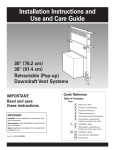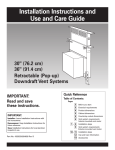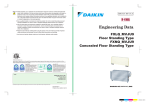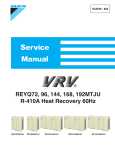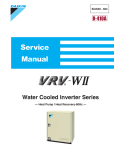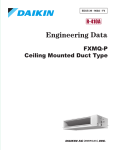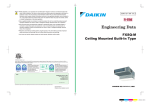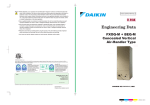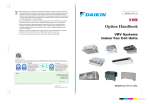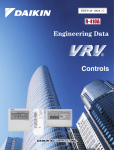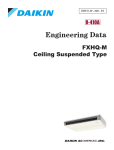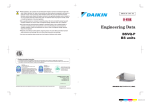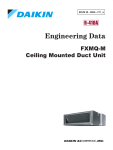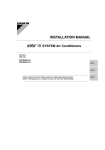Download Daikin FXHQ-M Specifications
Transcript
EDUS 39 - 600 - F1_a FXFQ-M Ceiling Mounted Cassette Type (Multi Flow) AMERICAS EDUS39-600-F1_a FXFQ-M Ceiling Mounted Cassette Type (Multi Flow) 1. 2. 3. 4. 5. 6. 7. External Appearance...................................................................................2 Specifications ..............................................................................................3 Dimensions .................................................................................................5 Piping Diagrams..........................................................................................8 Wiring Diagrams..........................................................................................9 Electric Characteristics..............................................................................10 Capacity Tables ........................................................................................11 7.1 Cooling Capacity ........................................................................................ 11 7.2 Heating Capacity ........................................................................................ 12 8. Air Velocity and Temperature Distributions...............................................13 9. Sound Levels ............................................................................................18 10.Installation .................................................................................................19 11.Accessories...............................................................................................35 FXFQ-M 1 External Appearance EDUS39-600-F1_a 1. External Appearance FXFQ12~36M FXFQ-M 2 EDUS39-600-F1_a Specifications 2. Specifications Ceiling Mounted Cassette Type (Multi-Flow) FXFQ12MVJU FXFQ18MVJU FXFQ24MVJU Cooling Capacity1 Model Btu/h 12,000 18,000 24,000 Heating Capacity2 Btu/h 13,500 20,000 27,000 Galvanized Steel Plate Galvanized Steel Plate Galvanized Steel Plate in (mm) 9-1/8 × 33-1/8 × 33-1/8 (231.8 x 841.4 x 841.4) 9-1/8 × 33-1/8 × 33-1/8 (231.8 x 841.4 x 841.4) 9-1/8 × 33-1/8 × 33-1/8 (231.8 x 841.4 x 841.4) 2 × 8 × 17 2 × 8 × 17 2×8×17 ft² (m²) 3.56’ (1.1 m) 3.56’ (1.1 m) 3.56’ (1.1 m) Model QTS45B14M QTS45B14M QTS45B14M Type Turbo Fan Turbo Fan Turbo Fan Casing / Color Dimensions: (H × W × D) Coil (Cross Fin Coil) Fan Rows × Stages × FPI Face Area Motor Output kW 0.04 0.04 0.04 Air Flow Rate (H/L) cfm 460/350 570/390 670/490 Drive Temperature Control Sound Absorbing Thermal Insulation Material Piping Connections Direct Drive Direct Drive Direct Drive Microprocessor Thermostat for Cooling and Heating Microprocessor Thermostat for Cooling and Heating Microprocessor Thermostat for Cooling and Heating Foamed Polystyrene / Foamed Polyethylene Foamed Polystyrene / Foamed Polyethylene Foamed Polystyrene / Foamed Polyethylene Liquid Pipes in / mm φ1/4” / 6.4 mm (Flare Connection) φ1/4” / 6.4 mm (Flare Connection) φ3/8” / 9.5 mm (Flare Connection) Gas Pipes in / mm φ1/2” / 12.7 mm (Flare Connection) φ1/2” / 12.7 mm (Flare Connection) φ5/8” / 15.8 mm (Flare Connection) Drain Pipe in / mm VP25 External Dia. 1-1/4” / 31.8 mm Internal Dia. 1” / 25.4 mm VP25 External Dia. 1-1/4” / 31.8 mm Internal Dia. 1” / 25.4 mm VP25 External Dia. 1-1/4” / 31.8 mm Internal Dia. 1” / 25.4 mm Machine Weight (Mass) Lbs 55 55 55 Sound Level (H/L)4 dBA 31/28 33/28 34/29 Fuse, Thermal Protector for Fan Motor Fuse, Thermal Protector for Fan Motor Fuse, Thermal Protector for Fan Motor Electronic Expansion Valve Electronic Expansion Valve Electronic Expansion Valve R-410A Series R-410A Series R-410A Series Model BYC125K-W1 BYC125K-W1 BYC125K-W1 Color White (10Y9/0.5) White (10Y9/0.5) White (10Y9/0.5) 1-5/8 × 37-3/8 × 37-3/8 (41.3x 949.3 x 949.3 1-5/8 × 37-3/8 × 37-3/8 (41.3x 949.3 x 949.3 1-5/8 × 37-3/8 × 37-3/8 (41.3x 949.3 x 949.3 Resin Net (with Mold Resistant) Resin Net (with Mold Resistant) Resin Net (with Mold Resistant) Safety Devices Refrigerant Control Connectable outdoor unit Decoration Panels (Option) Dimensions: (H × W × D) in (mm) Air Filter Weight Standard Accessories Lbs 11 11 11 Operation manual, Installation manual, Paper pattern for installation, Drain hose, Clamp metal, Washers, Sealing pads, Clamps, Screws, Insulation for fitting. Operation manual, Installation manual, Paper pattern for installation, Drain hose, Clamp metal, Washers, Sealing pads, Clamps, Screws, Insulation for fitting. Operation manual, Installation manual, Paper pattern for installation, Drain hose, Clamp metal, Washers, Sealing pads, Clamps, Screws, Insulation for fitting. Drawing No. C:3D042686 Notes: 1. Nominal cooling capacities are based on the following conditions: Return air temperature: 80°FDB, 67°FWB Outdoor temperature: 95°FDB Equivalent ref. piping length: 25 ft / 7.5 m (Horizontal) 2. Nominal heating capacities are based on the following conditions: Return air temperature: 70°FDB. Outdoor temperature: 47°FDB, 43°FWB Equivalent ref. piping length: 25 ft / 7.5 m (Horizontal) 3. Capacities are net, including a deduction for cooling (an addition for heating) for indoor fan motor heat. 4. Anechoic chamber conversion value, measured under JISB8616 conditions. During actual operation, these values are normally somewhat higher as a result of installation conditions. 5. Refer to page 10 for Power Input. FXFQ-M 3 Specifications EDUS39-600-F1_a Ceiling Mounted Cassette Type (Multi-Flow) FXFQ30MVJU FXFQ36MVJU Cooling Capacity1 Model Btu/h 30,000 36,000 Heating Capacity2 Btu/h 34,000 40,000 Galvanized Steel Plate Galvanized Steel Plate 11-3/8 × 33-1/8 × 33-1/8” (288.9 x 841.4 x 841.4 mm) 11-3/8 × 33-1/8 × 33-1/8” (288.9 x 841.4 x 841.4 mm) 2 × 12 × 17 2×12×17 Casing / Color Dimensions: (H×W×D) Coil (Cross Fin Coil) in (mm) Rows × Stages × FPI Face Area ft² Model Type Fan 5.35 QTS45A17M QTS45A17M Turbo Fan Turbo Fan Motor Output kW 0.09 0.09 Air Flow Rate (H/L) cfm 990/710 990/740 Drive Temperature Control Sound Absorbing Thermal Insulation Material Piping Connections 5.35 Direct Drive Direct Drive Microprocessor Thermostat for Cooling and Heating Microprocessor Thermostat for Cooling and Heating Foamed Polystyrene / Foamed Polyethylene Foamed Polystyrene / Foamed Polyethylene Liquid Pipes in / mm φ3/8” / 9.5 mm (Flare Connection) φ3/8” / 9.5 mm (Flare Connection) Gas Pipes in / mm φ5/8” / 15.8mm (Flare Connection) φ5/8” / 15.8mm (Flare Connection) Drain Pipe in (mm) VP25 External Dia. 1-1/4” (31.8mm) Internal Dia. 1” (25.4 mm VP25 External Dia. 1-1/4” (31.8mm) Internal Dia. 1” (25.4 mm) Machine Weight (Mass) Lbs 66 66 Sound Level (H/L)4 dBA 38/32 40/33 Fuse, Thermal Protector for Fan Motor Fuse, Thermal Protector for Fan Motor Electronic Expansion Valve Electronic Expansion Valve R-410A Series R-410A Series Safety Devices Refrigerant Control Connectable outdoor unit Decoration Panels (Option) Model BYC125K-W1 BYC125K-W1 Color White (10Y9/0.5) White (10Y9/0.5) 1-5/8 × 37-3/8 × 37-3/8” (41.3 x 949.3 x 949.3 mm) 1-5/8 × 37-3/8 × 37-3/8” (41.3 x 949.3 x 949.3 mm) Resin Net (with Mold Resistant) Resin Net (with Mold Resistant) Dimensions: (H × W × D) in (mm) Air Filter Weight Standard Accessories Lbs 11 11 Operation manual, Installation manual, Paper pattern for installation, Drain hose, Clamp metal, Washers, Sealing pads, Clamps, Screws, Insulation for fitting. Drawing No. Operation manual, Installation manual, Paper pattern for installation, Drain hose, Clamp metal, Washers, Sealing pads, Clamps, Screws, Insulation for fitting. C:3D042686 Notes: 1. Nominal cooling capacities are based on the following conditions: Return air temperature: 80°FDB, 67°FWB Outdoor temperature: 95°FDB Equivalent ref. piping length: 25 ft / 7.5 m (Horizontal) 2. Nominal heating capacities are based on the following conditions: Return air temperature: 70°FDB. Outdoor temperature: 47°FDB, 43°FWB Equivalent ref. piping length: 25 ft / 7.5 m (Horizontal) 3. Capacities are net, including a deduction for cooling (an addition for heating) for indoor fan motor heat. 4. Anechoic chamber conversion value, measured under JISB8616 conditions. During actual operation, these values are normally somewhat higher as a result of installation conditions. 5. Refer to page 10 for Power Input. FXFQ-M 4 EDUS39-600-F1_a Dimensions 3. Dimensions 3D042631 FXFQ12MVJU FXFQ18MVJU FXFQ-M 5 Dimensions EDUS39-600-F1_a 3D042632 FXFQ24MVJU FXFQ-M 6 EDUS39-600-F1_a Dimensions 3D042633A FXFQ30MVJU FXFQ36MVJU FXFQ-M 7 Piping Diagrams EDUS39-600-F1_a 4. Piping Diagrams Gas piping connection port Heat exchanger R3T R1T Fan R2T Liquid piping connection port Filter Electronic Filter expansion valve C:4D024460A R1T : Thermistor for suction air temperature R2T : Thermistor for liquid line temperature R3T : Thermistor for gas line temperature FXFQ-M Capacity Gas Liquid 12/18 M φ1/2” (12.7 mm) φ1/4” (6.4 mm) 24/30/36 M φ5/8” (15.8 mm) φ3/8” (9.5 mm) 8 EDUS39-600-F1_a Wiring Diagrams 5. Wiring Diagrams 3D042620B FXFQ12M/18M/24M/30M/36MVJU FXFQ-M 9 Electric Characteristics EDUS39-600-F1_a 6. Electric Characteristics FXFQ-M 10 EDUS39-600-F1_a Capacity Tables 7. Capacity Tables 7.1 Cooling Capacity FXFQ-M Cooling capacity Indoor Air Temp. °FWB Unit size Outdoor air temp. °FDB 12 18 24 30 36 75 79 83 87 91 95 99 103 75 79 83 87 91 95 99 103 75 79 83 87 91 95 99 103 75 79 83 87 91 95 99 103 75 79 83 87 91 95 99 103 61 64 67 70 72 75 TC SHC TC SHC TC SHC TC SHC TC SHC TC SHC MBh MBh MBh MBh MBh MBh MBh MBh MBh MBh MBh MBh 9.5 9.5 9.5 9.5 9.5 9.5 9.5 9.5 14.2 14.2 14.2 14.2 14.2 14.2 14.2 14.2 18.9 18.9 18.9 18.9 18.9 18.9 18.9 18.9 23.7 23.7 23.7 23.7 23.7 23.7 23.7 23.7 28.4 28.4 28.4 28.4 28.4 28.4 28.4 28.4 8.1 8.1 8.1 8.1 8.1 8.1 8.1 8.1 11.1 11.1 11.1 11.1 11.1 11.1 11.1 11.1 15.0 15.0 15.0 15.0 15.0 15.0 15.0 15.0 20.1 20.1 20.1 20.1 20.1 20.1 20.1 20.1 21.9 21.9 21.9 21.9 21.9 21.9 21.9 21.9 10.7 10.7 10.7 10.7 10.7 10.7 10.7 10.7 16.1 16.1 16.1 16.1 16.1 16.1 16.1 16.1 21.5 21.5 21.5 21.5 21.5 21.5 21.5 21.5 26.8 26.8 26.8 26.8 26.8 26.8 26.8 26.8 32.2 32.2 32.2 32.2 32.2 32.2 32.2 32.2 8.8 8.8 8.8 8.8 8.8 8.8 8.8 8.8 11.9 11.9 11.9 11.9 11.9 11.9 11.9 11.9 16.1 16.1 16.1 16.1 16.1 16.1 16.1 16.1 21.2 21.2 21.2 21.2 21.2 21.2 21.2 21.2 23.5 23.5 23.5 23.5 23.5 23.5 23.5 23.5 12.0 12.0 12.0 12.0 12.0 12.0 12.0 12.0 18.0 18.0 18.0 18.0 18.0 18.0 18.0 18.0 24.0 24.0 24.0 24.0 24.0 24.0 24.0 24.0 30.0 30.0 30.0 30.0 30.0 30.0 30.0 30.0 36.0 36.0 36.0 36.0 36.0 36.0 36.0 36.0 9.4 9.4 9.4 9.4 9.4 9.4 9.4 9.4 12.8 12.8 12.8 12.8 12.8 12.8 12.8 12.8 17.5 17.5 17.5 17.5 17.5 17.5 17.5 17.5 23.1 23.1 23.1 23.1 23.1 23.1 23.1 23.1 25.2 25.2 25.2 25.2 25.2 25.2 25.2 25.2 13.3 13.3 13.3 13.2 13.0 12.7 12.5 12.3 19.9 19.9 19.9 19.8 19.4 19.1 18.8 18.4 26.5 26.5 26.5 26.4 25.9 25.5 25.0 24.6 33.2 33.2 33.2 33.0 32.4 31.8 31.3 30.7 39.8 39.8 39.8 39.5 38.9 38.2 37.5 36.8 9.4 9.4 9.4 9.4 9.3 9.2 9.1 9.1 13.3 13.3 13.3 13.2 13.2 13.2 13.1 13.1 17.8 17.8 17.8 17.7 17.5 17.2 17.0 16.7 23.5 23.5 23.5 23.5 23.3 23.0 22.8 22.7 26.3 26.3 26.3 26.2 25.8 25.4 25.1 24.7 14.0 13.8 13.6 13.3 13.1 12.9 12.7 12.4 21.0 20.7 20.4 20.0 19.7 19.3 19.0 18.7 28.0 27.6 27.1 26.7 26.2 25.8 25.3 24.9 35.1 34.5 33.9 33.4 32.8 32.2 31.7 31.1 42.1 41.4 40.7 40.0 39.4 38.7 38.0 37.3 9.5 9.5 9.4 9.3 9.3 9.2 9.1 9.1 13.5 13.3 13.2 13.1 13.0 12.9 12.7 12.7 18.2 18.0 17.8 17.5 17.2 17.0 16.7 16.4 23.8 23.6 23.4 23.2 23.0 22.7 22.4 22.1 26.5 26.2 25.8 25.4 25.0 24.6 24.3 23.9 14.3 14.0 13.8 13.6 13.4 13.1 12.9 12.7 21.4 21.1 20.7 20.4 20.1 19.7 19.4 19.0 28.5 28.1 27.6 27.2 26.7 26.3 25.8 25.4 35.7 35.1 34.5 34.0 33.4 32.9 32.3 31.7 42.8 42.1 41.5 40.8 40.1 39.4 38.8 38.1 9.6 9.6 9.5 9.4 9.4 9.3 9.3 9.3 13.3 13.3 13.2 13.1 12.9 12.8 12.8 12.8 17.7 17.6 17.4 17.2 17.0 16.7 16.5 16.2 22.1 21.9 21.7 21.4 21.2 20.9 20.6 20.3 25.7 25.4 25.0 24.7 24.3 23.9 23.6 23.2 TC : Total capacity ; kW SHC : Sensible heat capacity ; kW Refer to Outdoor Unit Capacity Tables for the actual performance data of each indoor and outdoor unit combination. FXFQ-M 11 Capacity Tables 7.2 EDUS39-600-F1_a Heating Capacity FXFQ-M Heating Capacity Indoor Air Temp. °FDB Indoor unit Outdoor Air Temp. °FDB 12 18 24 30 36 22.0 26.0 30.0 35.0 39.0 44.0 47.0 51.0 54.0 57.0 60.0 22.0 26.0 30.0 35.0 39.0 44.0 47.0 51.0 54.0 57.0 60.0 22.0 26.0 30.0 35.0 39.0 44.0 47.0 51.0 54.0 57.0 60.0 22.0 26.0 30.0 35.0 39.0 44.0 47.0 51.0 54.0 57.0 60.0 22.0 26.0 30.0 35.0 39.0 44.0 47.0 51.0 54.0 57.0 60.0 °FWB 20.0 24.0 28.0 32.0 36.0 40.0 43.0 47.0 50.0 53.0 56.0 20.0 24.0 28.0 32.0 36.0 40.0 43.0 47.0 50.0 53.0 56.0 20.0 24.0 28.0 32.0 36.0 40.0 43.0 47.0 50.0 53.0 56.0 20.0 24.0 28.0 32.0 36.0 40.0 43.0 47.0 50.0 53.0 56.0 20.0 24.0 28.0 32.0 36.0 40.0 43.0 47.0 50.0 53.0 56.0 62 65 68 70 72 75 TC TC TC TC TC TC MBh MBh MBh MBh MBh MBh 11.7 12.2 12.8 13.3 13.9 14.5 14.9 15.4 15.5 15.5 15.5 17.5 18.3 19.2 20.0 20.8 21.7 22.3 23.1 23.2 23.2 23.2 23.3 24.5 25.6 26.7 27.8 28.9 29.7 30.8 31.0 31.0 31.0 29.2 30.6 32.0 33.3 34.7 36.1 37.2 38.6 38.7 38.7 38.7 35.0 36.7 38.4 40.0 41.7 43.4 44.6 46.3 46.5 46.5 46.5 11.7 12.2 12.8 13.3 13.9 14.4 14.7 14.7 14.7 14.7 14.7 17.5 18.3 19.1 20.0 20.8 21.6 22.1 22.1 22.1 22.1 22.1 23.3 24.4 25.5 26.6 27.7 28.9 29.5 29.5 29.5 29.5 29.5 29.1 30.5 31.9 33.3 34.7 36.1 36.9 36.9 36.9 36.9 36.9 35.0 36.6 38.3 40.0 41.6 43.3 44.2 44.2 44.2 44.2 44.2 11.6 12.2 12.7 13.3 13.9 14.0 14.0 14.0 14.0 14.0 14.0 17.4 18.3 19.1 19.9 20.8 21.0 21.0 21.0 21.0 21.0 21.0 23.3 24.4 25.5 26.6 27.7 28.0 28.0 28.0 28.0 28.0 28.0 29.1 30.5 31.9 33.2 34.6 35.0 35.0 35.0 35.0 35.0 35.0 34.9 36.6 38.2 39.9 41.6 42.0 42.0 42.0 42.0 42.0 42.0 11.6 12.2 12.7 13.3 13.5 13.5 13.5 13.5 13.5 13.5 13.5 17.4 18.3 19.1 19.9 20.0 20.0 20.0 20.0 20.0 20.0 20.0 23.2 24.3 25.5 26.6 27.0 27.0 27.0 27.0 27.0 27.0 27.0 29.0 30.4 31.8 33.2 34.0 34.0 34.0 34.0 34.0 34.0 34.0 34.8 36.5 38.2 39.8 40.0 40.0 40.0 40.0 40.0 40.0 40.0 11.6 12.2 12.7 13.0 13.0 13.0 13.0 13.0 13.0 13.0 13.0 17.4 18.2 19.1 19.5 19.5 19.5 19.5 19.5 19.5 19.5 19.5 23.2 24.3 25.4 26.0 26.0 26.0 26.0 26.0 26.0 26.0 26.0 29.0 30.4 31.8 32.5 32.5 32.5 32.5 32.5 32.5 32.5 32.5 34.8 36.5 38.1 39.0 39.0 39.0 39.0 39.0 39.0 39.0 39.0 11.6 12.1 12.3 12.3 12.3 12.3 12.3 12.3 12.3 12.3 12.3 17.4 18.2 18.4 18.4 18.4 18.4 18.4 18.4 18.4 18.4 18.4 23.2 24.3 24.5 24.5 24.5 24.5 24.5 24.5 24.5 24.5 24.5 28.9 30.3 30.6 30.6 30.6 30.6 30.6 30.6 30.6 30.6 30.6 34.7 36.4 36.8 36.8 36.8 36.8 36.8 36.8 36.8 36.8 36.8 Refer to Outdoor Unit Capacity Tables for the actual performance data of each indoor and outdoor unit combination. FXFQ-M 12 EDUS39-600-F1_a Air Velocity and Temperature Distributions 8. Air Velocity and Temperature Distributions FXFQ12M <Cooling mode> AIRFLOW DISTRIBUTIONS TEMPERATURE DISTRIBUTIONS FXFQ12M <Heating mode> AIRFLOW DISTRIBUTIONS TEMPERATURE DISTRIBUTIONS 3D052941 FXFQ-M 13 Air Velocity and Temperature Distributions EDUS39-600-F1_a FXFQ18M <Cooling mode> AIRFLOW DISTRIBUTIONS TEMPERATURE DISTRIBUTIONS FXFQ18M <Heating mode> AIRFLOW DISTRIBUTIONS TEMPERATURE DISTRIBUTIONS 3D052942 FXFQ-M 14 EDUS39-600-F1_a Air Velocity and Temperature Distributions FXFQ24M <Cooling mode> AIRFLOW DISTRIBUTIONS TEMPERATURE DISTRIBUTIONS FXFQ24M <Heating mode> AIRFLOW DISTRIBUTIONS TEMPERATURE DISTRIBUTIONS 3D052943 FXFQ-M 15 Air Velocity and Temperature Distributions EDUS39-600-F1_a FXFQ30M <Cooling mode> AIRFLOW DISTRIBUTIONS TEMPERATURE DISTRIBUTIONS FXFQ30M <Heating mode> AIRFLOW DISTRIBUTIONS TEMPERATURE DISTRIBUTIONS 3D052944 FXFQ-M 16 EDUS39-600-F1_a Air Velocity and Temperature Distributions FXFQ36M <Cooling mode> AIRFLOW DISTRIBUTIONS TEMPERATURE DISTRIBUTIONS FXFQ36M <Heating mode> AIRFLOW DISTRIBUTIONS TEMPERATURE DISTRIBUTIONS 3D052945 FXFQ-M 17 Sound Levels EDUS39-600-F1_a 9. Sound Levels Overall Ceiling Mounted Cassette Type (Multi Flow) Notes: Operation noise differs with operation and ambient conditions. dBA Model 208~230V, 60Hz H L FXFQ12MVJU 31 28 FXFQ18MVJU 33 28 FXFQ24MVJU 34 29 FXFQ30MVJU 38 32 FXFQ36MVJU 40 33 Octave Band Level 208V~230V FXFQ12MVJU FXFQ18MVJU 4D052508 4D052507 FXFQ30MVJU 4D052509 FXFQ36MVJU 4D052510 FXFQ-M FXFQ24MVJU 4D052511 18 EDUS39-600-F1_a Installation 10. Installation Center of Gravity (inches) FXFQ12, 18, 24MVJU FXFQ30, 36MVJU A 9-1/8 11-3/8 B 4-1/2 6-3/4 4D042639A FXFQ-M 19 Installation 1. SAFETY CONSIDERATIONS Read these SAFETY CONSIDERATIONS carefully before installing air conditioning equipment, and be sure to install it correctly. After completing the installation, make sure that the unit operates properly during the start-up operation. Instruct the customer how to operate and maintain the unit. Inform customers that they should store this Installation Manual with the Operation Manual for future reference. Always use a licensed installer or contractor to install this product. Improper installation can result in water or refrigerant leakage, electrical shock, fire, or explosion. Meanings of DANGER, WARNING, CAUTION, and NOTE symbols: DANGER .............. Indicates an imminently hazardous situation which, if not avoided, results in death or serious injury. WARNING ............ Indicates a potentially hazardous situation which, if not avoided, could result in death or serious injury. CAUTION ............. Indicates a potentially hazardous situation which, if not avoided, may result in minor or moderate injury. It may also be used to alert against unsafe practices. NOTE .................... Indicates situations that may result in equipment or property-damage accidents only. DANGER • Do not ground units to water pipes, telephone wires, or lightning rods because incomplete grounding can cause a severe shock hazard resulting in severe injury or death. Do not ground units to gas pipes because a gas leak can result in an explosion which could lead to severe injury or death. • Do not install unit in an area where flammable materials are present due to risk of explosions that can cause serious injury or death. • Refrigerant gas is heavier than air and displaces oxygen. A massive leak can lead to oxygen depletion, especially in basements, and an asphyxiation hazard could occur leading to serious injury or death. • If equipment utilizing a burner is used in the same room as the air conditioner, there is danger of oxygen deficiency which can lead to asphyxiation resulting in serious injury or death. Be sure to ventilate the room sufficiently to avoid this hazard. • If the refrigerant gas leaks during installation, ventilate the area immediately. Refrigerant gas may produce toxic gas if it comes in contact with fire such as from a fan, heater, stove or cooking device. Exposure to this gas could result in severe injury or death. • After completing the installation work, check that the refrigerant gas does not leak. Refrigerant gas may produce toxic gas if it comes in contact with fire from a fan, heater, stove, cooking device, or other heat source. Exposure to this gas can cause severe injury or death. FXFQ-M EDUS39-600-F1_a • Safely dispose of the packing materials. Packing materials such as nails and other metal or wooden parts, may cause stabs or other injuries. Tear apart and throw away plastic packaging bags so that children do not play with them and risk death by suffocation. WARNING • Ask your dealer or qualified personnel to carry out installation work. Do not try to install the machine by yourself. Improper installation may result in water leakage, electric shocks, or fire. • Perform installation work in accordance with this installation manual. Improper installation may result in water leakage, electric shocks, or fire. • Be sure to use only the specified accessories and parts for installation work. Failure to use the specified parts may result in water leakage, electric shocks, fire, or the unit falling. • Carry out the specified installation work after taking into account strong winds, typhoons, or earthquakes. Improper installation work may result in the equipment falling and causing accidents. • Check the unit stand for for damage on a continual basis, especially if it has been used for a long time. If left in a damanged condition the unit may fall and cause injury. • Do not allow children to play on or around the unit as they can be injured. • Make sure that a separate power supply circuit is provided for this unit and that all electrical work is carried out by qualified personnel according to local laws and regulations, and this installation manual. An insufficient power supply capacity or improper electrical construction may lead to electric shocks or fire. • Make sure that all wiring is secured, the specified wires are used, and that no external forces act on the terminal connections or wires. Improper connections or installation may result in fire. • When wiring the power supply and connecting the remote controller wiring and transmission wiring, position the wires so that the electric parts box lid can be securely fastened. Improper positioning of the electric parts box lid may result in electric shocks, fire, or the terminals overheating. • Before touching electrical parts, turn off the unit. • Be sure to establish a ground. Do not ground the unit to a utility pipe, arrester, or telephone ground. Incomplete ground may cause electrical shock, or fire. A high surge current from lightning or other sources may cause damage to the air conditioner. • Placing a flower vase or other containers with water or other liquids can result in a shock hazard or fire if spilling occurs. • Do not put a finger or other objects into the air inlet or air outlet as the fan is rotating at a high speed and will cause injury. 20 EDUS39-600-F1_a • Do not touch the air outlet or horizontal flaps while the swing flap is in operation as fingers may get caught and injured. • Do not touch the switch with wet fingers. Touching a switch with wet fingers can cause electric shock. • Be sure to install a ground leakage breaker. Failure to install a ground leakage breaker may result in electric shocks, or fire. • Do not install the air conditioner in the following locations: (a) Where a mineral oil mist or oil spray or vapor is produced, for example, in a kitchen. Plastic parts may deteriorate and fall off or result in water leakage. (b) Where corrosive gas, such as sulfurous acid gas, is produced. Corroding copper pipes or soldered parts may result in refrigerant leakage. (c) Near machinery emitting electromagnetic waves Electromagnetic waves may disturb the operation of the control system and result in a malfunction of the equipment. (d) where flammable gases may leak, where there are carbon fiber or ignitable dust suspensions in the air, or where volatile flammables such as thinner or gasoline are handled. Operating the unit in such conditions may result in fire. • Heat exchanger fins are sharp enough to cut. To avoid injury wear gloves to cover the fins when working around them. • Refrigerant pipes may be very hot or very cold during or immediately after operation. Touching them could result in burns or frostbite. To avoid injury give the pipes time to return to normal temperature or, if you must touch them, be sure to wear proper gloves. Installation visions or radios in order to prevent image interference or noise. (Depending on the radio waves, a distance of 3.5 ft. may not be sufficient to eliminate the noise.) • Remote controller (wireless kit) transmitting distance is shorter than expected in rooms with electronic fluorescent lamps Install the indoor unit as far away from fluorescent lamps as possible. • Dismantling of the unit, and treatment of the refrigerant, oil, and other parts, should be done in accorandce with the relevant local and national regulatio CAUTION • While following the instructions in this installation manual, install drain piping in order to ensure proper drainage and insulate piping in order to prevent condensation. Improper drain piping may result in water leakage and property damage. • Be very careful about product transportation. Some products use PP bands for packaging. Do not use any PP bands for a means of transportation. It is dangerous. • Do not turn off the power immediately after stopping operation. • Always wait at least five minutes before turning off the power. to prevent leaks or other problems. Take adequate measures to prevent outdoor unit from being used as a shelter by small animals. Small animals making contact with electrical parts can cause malfunctions, smoke or fire. Please instruct the customer to keep the area around the unit clean. NOTE • Install the indoor and outdoor units, power supply wiring, and connecting wires at least 3.5 ft. away from tele- FXFQ-M 21 Installation 2. BEFORE INSTALLATION • When moving the unit while removing it from the packing case, be sure to lift it by the four hanger brackets. Avoid putting any pressure on other parts, especially, the refrigerant piping, drain piping, and other resin parts. • Be sure to check the type of R-410A refrigerant to be used before installing the unit. (Using an incorrect refrigerant will prevent normal operation of the unit.) • The accessories needed for installation must be retained in your custody until the installation work is completed. Do not discard them! • Decide upon a line of transport. • Leave the unit inside its packaging while moving, until reaching the installation site. Where unpacking is unavoidable, use a sling of soft material or protective plates together with a rope when lifting, to avoid damage or scratches to the unit. • When moving the unit at or after opening, hold the unit by the hanger brackets (× 4). Do not apply force to the refrigerant piping, drain piping or plastic parts. • For the installation of an outdoor unit, refer to the installation manual attached to the outdoor unit. • Do not install or operate the unit in rooms mentioned below. • Laden with mineral oil, or filled with oil vapor or spray like in kitchens. (Plastic parts may deteriorate which could eventually cause the unit to fall out of place, or could lead to leaks.) • Where corrosive gas like sulfurous gas exists. (Copper tubing and brazed spots may corrode which could eventually lead to refrigerant leaks.) • Where exposed to combustible gases and where volatile flammable gas like thinner or gasoline is used. (Gas in the vicinity of the unit could ignite.) • Where machines can generate electromagnetic waves. (Control system may malfunction.) • Where the air contains high levels of salt such as that near the ocean and where voltage fluctuates greatly such as that in factories. Also in vehicles or vessels. • This unit, both indoor and outdoor, is suitable for installation in a commercial and light industrial environment. If installed as a household appliance it could cause electromagnetic interference. EDUS39-600-F1_a • Where machines generate electromagnetic wves and cause the control system to malfunction. • Where the air contrains high levels of salt as near the ocean, and where voltage fluctuates greatly as in factories, vehicles, or vessels. • Entrust installation to the place of purchase or a qualified serviceman. Improper installation can result in leaks or even electric shock or fire. • Use of unspecified parts could result in the unit falling, leaks, or even electric shock or fire. Be sure to read this manual before installing the indoor unit. • Be sure to procure an air filter in the field and mount it in the suction air passage to prevent water leaks or other problems. NOTE • Be sure to read this manual before installing the indoor unit. • Be sure to mount an air filter (part to be procured in the field) in the suction air passage in order to prevent water leaking or other problems. WARNING • Entrust installation to the place of purchase or a qualified serviceman. Improper installation could lead to leaks and, in worse cases, electric shock of fire. • Use of unspecified parts could lead to the unit falling, leaks and, in worse cases, electric shock or fire. CAUTION • Do not install or operate the unit in the following areas: • Kitchens or rooms that might be laden with mineral oil, or filled with oil vapor or spray. Plastic parts may deteriorate and eventually cause the unit to fall out of place or leak. • Where sulfurous or other corrosive gas exists. Copper tubing and brazed spots may corrode and lead to refrigerant leaks. 22 FXFQ-M EDUS39-600-F1_a 2-1 Installation ACCESSORIES Check the following accessories are included with your unit. Name 1) Drain hose 2) Metal clamp 3) Washer for hanger bracket 4) Clamp Quantity 1 pc. 1 pc. 8 pcs. 4 pcs. Shape Name 5) Paper pattern for installation 6) Screws (M5) 7) Washer fixing plate Insulation for fitting Quantity 1 pc. 4 pcs. 4 pcs. 1 each Also used as packing material For paper pattern for installation Shape 8) for gas pipe 9) for liquid pipe Name Quantity Sealing pad 1 each 2 pcs. (Other) Installation manual Shape 10) Large a. Items to be checked after completion of work Items to be checked Are the indoor and outdoor unit fixed firmly? Is the gas leak test finished? Is the unit fully insulated? Does drainage flow smoothly? Does the power supply voltage correspond to that shown on the name plate? Are wiring and piping correct? If not properly done, what is Check likely to occur. The units may drop, vibrate or make noise. It may result in insufficient cooling. Condensate water may drip. Condensate water may drip. The unit may malfunction or the components burn out. The unit may malfunction or the components burn out. Dangerous at electric leakIs the unit safely grounded? age. Is wiring size according to The unit may malfunction or specifications? the components burn out. Is something blocking the It may result in insufficient air outlet or inlet of either cooling. the indoor or outdoor units? Are refrigerant piping length The refrigerant charge in and additional refrigerant the system is not clear. charge noted down? b. Items to be checked at time of delivery Also review the SAFETY CONSIDERATIONS Items to be checked Operation manual 12) Small Check Did you explain about operations while showing the operation manual to your customer? Did you hand the operation manual over to your customer? 11) Medium 2-2 FOR THE FOLLOWING ITEMS, TAKE SPECIAL CARE DURING CONSTRUCTION AND CHECK AFTER INSTALLATION IS FINISHED. 2-3 OPTIONAL ACCESSORIES • The optional decoration panel and remote controller are required for this indoor unit. Table 1 NOTE TO INSTALLER • Be sure to instruct customers how to properly operate the unit (especially cleaning filters, operating different functions, and adjusting the temperature) by having them carry out operations themselves while looking at the manual. Optional decoration panel Model Color FXFQ12 · 18 · 24 · 30 · 36MVJU White BYC125KW1 Table 2 Remote controller Wired type FXFQ-M BRC1D71 23 Installation 3. EDUS39-600-F1_a SELECTING INSTALLATION SITE Attach an additional insulation pipe cover to the unit body when it is believed that the relative humidity in the ceiling exceeds 80%. Use glass wool, polyethylene foam, or something similar with a minimum 3/8 inch thickness as insulation. For this unit, you are able to select air flow direction. To enable the discharge of air in 2 or 3 directions, it is necessary to purchase the optional blocking pad kit. (1) Select an installation site where the following conditions are fulfilled and that meets with your customer’s approval: • No possible dripping of water from the refrigerant pipe, drain pipe, or water pipe into the upper space of the indoor unit, including the back of the ceiling. • Optimum air distribution can be ensured. • Nothing blocks air passage. • Condensate can be properly drained. • False ceiling is not noticeably on an incline. • Sufficient clearance for maintenance and service can be ensured. • Piping between indoor and outdoor units is possible within the allowable limit. Refer to the installation manual of the outdoor unit. (3) Airflow direction The below figures are approximations. Select airflow directions best suited to the room and point of installation. For air discharge in 2 or 3 directions, it is necessary to make field settings by remote controller and to close the air outlet(s). Refer to the section FIELD SETTING in the installation manual of the optional blocking pad kit. [Air flow direction] Air discharge in 4 directions Air discharge in 3 directions Air discharge in 2 directions (4) Use suspension bolts for installation. Ensure the ceiling is strong enough to support the weight of the unit If any risk, reinforce the ceiling before installing the unit. (5) Refer to the installation pattern for instructions and to check for points requiring reinforcing.) [Space required for installation] DANGER H • Do not install unit in an area where flammable materials are present due to risk of explosion resulting in serious injury or death. • If supporting structural members are not strong enough to take the unit’s weight, the unit could fall out of place and cause serious injury. *59 or more NOTE Air discharge 39 3/8 or more WARNING Air Air discharge inlet *59 or more H • Install the indoor and outdoor units, power supply wiring and connecting wires at least 3.5ft. away from televisions or radios in order to prevent image interference or noise. Depending on the radio waves, a distance of 3.5 ft. may not be enough to eliminate the noise. (2) Ceiling height This indoor unit may be installed on ceilings up to 11.5 ft. (30, 36: 13.8 ft.) in height as shown in the following table: Number of discharge outlets used FXFQ12M~24M Ceiling height Standard 4-way air discharge 3-way air discharge 2-way air discharge 8.9 9.9 11.5 *59 or more Air Air inlet Air discharge discharge *59 or more NOTE) Leave 7 7/8 or more space where marked with the *, on sides where the air outlet is closed. Number of discharge outlets used FXFQ30M·36M Ceiling height 24 Standard 4-way air discharge 3-way air discharge 2-way air discharge 10.5 11.8 13.8 Model FXFQ12 · 18 · 24MVJU FXFQ30 · 36MVJU H 9 7/16 or more 11 3/4 or more (length: in.) FXFQ-M EDUS39-600-F1_a 4. Installation PREPARATIONS BEFORE INSTALLATION (1) Relation of ceiling opening to unit and suspension bolt position 33 1/16 (Indoor unit) 30 11/16 (Suspension bolt pitch) 34 5/8 (Ceiling opening) 37 3/8 (Decoration panel) Refrigerant piping Suspension bolt (×4) 26 3/4 (Suspension bolt pitch) 33 1/16 (Indoor unit) 34 5/8 (Ceiling opening) Ceiling material 37 3/8 (Decoration panel) 1 3/8 or less 1 3/8 or less A (5 7/8) Hanger bracket False ceiling [View as seen from A] (length: in.) Installation is possible when ceiling-opening dimensions are as follows: • (length: in.) NOTE) Installation is possible with a ceiling dimension of 35 13/16 (marked with *). However, to achieve a ceilingpanel overlapping dimension of 13/16, the spacing between the ceiling and the unit should be 1 3/8 or less. If the spacing between ceiling and the unit is over 1 3/8, attach false ceiling to part or recover the ceiling. (2) Make the ceiling opening needed for installation where applicable. (For existing ceilings) • Refer to the paper pattern for ceiling opening dimensions. • Create the ceiling opening required for installation. From the side of the opening to the casing outlet, implement the refrigerant, drain piping, and wiring for remote controller (unnecessary if wireless ) and indoor-outdoor unit casing outlet. Refer to each PIPING or WIRING section. • After making an opening in the ceiling, it may be necessary to reinforce ceiling beams to keep the ceiling level and to prevent it from vibrating. Consult the builder for details. (3) Install the suspension bolts using either a W3/8” or M10 size bolt. Use a hole-in anchor for existing ceilings, and a sunken insert, sunken anchor, or other new ceiling parts to reinforce the ceiling to bear the weight of the unit. Adjust clearance from the ceiling before proceeding further. 〈 Installation example 〉 Ceiling slap 1 15/16” ~ 3 15/16” Anchor Long nut or turn-buckle Suspension bolt False ceiling NOTE) All the above parts are field supplied. FXFQ-M 25 Installation 5. EDUS39-600-F1_a INSTALLATION PROCEDURES FOR FRESH AIR INTAKE DUCT CONNECTION (1) Cut off the knockout hole on the side plate. Then, cut the inner insulation of the hole portion. Refer to Fig. 1 (2) Adhere the insulation to the opening of the unit. to Fig. 2 Refer Drain pipe Pipe 6. INDOOR UNIT INSTALLATION Installing optional accessories (except for the decoration panel) before installing the indoor unit is easier. However, for existing ceilings, install fresh air inlet component kit and branch duct before installing the unit. (1) Install the indoor unit temporarily. • Attach the hanger bracket to the suspension bolt. Be sure to fix it securely by using a nut and washer from the upper and lower sides of the hanger bracket. The washer fixing plate ( 7) will prevent the washer from falling. Part to be procured in the field Washer 3) (attached) Hanger bracket Tighten (double nut) Inner insulation [Securing the hanger bracket] Side plate Cut it off with cutter. Cut it off with nipper Slit Side plate Inner insulation 6-1 Fig. 1 Insulation (field supply) Put the insulation tightly around the hole of the unit as shown. The ends of the side plate and the inner insulation must be completely adhered without leaving any clearance along the circumference of the hole. Inner insulation Side plate For new ceilings (1) Refer to the paper pattern for installation 5) for ceiling opening dimension. Consult the builder or carpenter for details. • The center of the ceiling opening is indicated on the paper pattern for installation. The center of the unit is indicated on the label attached to the unit and on the paper pattern for installation. • After removing the packaging material from the 4 corners of the paper pattern for installation (5), fix the paper pattern to the unit with the 4 screws (6). • Ceiling height is shown on the side of the paper pattern for installation (5). Adjust the height of the unit according to this indication. Edge Insulation Approx. 3/8” Make sure the inner surface of insulation tightly contacts with the inner insulation edge and the side plate. Fig. 2 26 FXFQ-M EDUS39-600-F1_a Installation 7. Ceiling material Lower surface of ceiling [Height adjustment of the unit.] 7-1 REFRIGERANT PIPING WORK GENERAL INSTRUCTIONS • For refrigerant piping of outdoor units, see the installation manual attached to the outdoor unit. • Before refrigerant piping work, check which type of refrigerant is used. Proper operation is not possible if the types of refrigerant are not the same. • The outdoor unit is charged with refrigerant. DANGER Center of the unit Center of ceiling opening Paper pattern for installation 5) • Refrigerant gas may produce toxic gas if it comes in contact with fire such as from a fan, heater, stove or cooking device. Exposure to this gas could result in severe injury or death. NOTE • Use a pipe cutter and flare suitable for the type of refrigerant. • To prevent dust, moisture or other foreign matter from infiltrating the tube, either pinch the end or cover it with tape. • Do not allow anything other than the designated refrigerant to get mixed into the refrigerant circuit, such as air. If any refrigerant gas leaks while working on the unit, ventilate the room immediately. . Screws 6) (attached) 7-2 [Installation of paper pattern for installation] Ceiling work (2) Adjust the unit to the correct position for installation. (Refer to Section 4. (1) PREPARATIONS BEFORE INSTALLATION, P. 67. (3) Make sure the unit is horizontally level. • The indoor unit is equipped with a built-in drain pump and float switch. At each of the unit’s 4 corners, verify that it is level by using a waterlevel or a water-filled vinyl tube. If the unit is inclined against condensate flow, the float switch may malfunction and cause water to drip. (4) Remove the washer-fixing plate (7) used for preventing the washer from falling and tighten the upper nut. (5) Remove the paper pattern for installation (5). Connecting the refrigerant piping • When connecting the flare nut, coat the flare both inside and outside with ester oil or ether oil and initially tighten by hand 3 or 4 turns before tightening firmly. Ester oil or ether oil. • To prevent flare nut cracking and gas leaks, be sure to use both a spanner and torque wrench together, as shown in the drawing below, when connecting or disconnecting pipes to/ from the unit. Torque wrench Spanner Piping union Flare nut Water level Vinyl tube 6-2 For existing ceilings (6) Adjust the height and position of the unit. Refer toPREPARATIONS BEFORE INSTALLATION-(1). (7) Perform steps (4), (5) in “6-1 For new ceilings”. FXFQ-M 27 Installation EDUS39-600-F1_a • Refer to Table 3 for the dimensions of flare nut spaces. • Refer to Table 3 to determine the proper tightening torque. Table 3 φ 1/4” 10.4 – 12.7 0.342-0.358 φ 3/8” 24.1 – 29.4 0.504-0.520 φ 1/2” 36.5 – 44.5 0.638-0.654 φ 5/8” 45.6 – 55.6 0.760-0.776 Flare shape (in.) Medium sealing pad (attached) 11) R0.0160.031 A Flare dimensions A (in.) 45˚±2˚ Tightening torque (ft.lbf) 90˚±0.5˚ Pipe size • Make absolutely sure to execute heat insulation works on the pipe-connecting section after checking gas leakage by thoroughly studying the following figure and using the attached heat insulating materials for fitting. Fasten both ends with the accessory clamps. • Wrap the sealing pad (accessory) only around the insulation for the joints on the gas piping side. (Wrap the piping union with the sealing pad.) Clamp 4) (×4) NOTE • Apply ester oil or ether oil around the flare portions before connecting. • The flare nuts used must be those included with the main body. • Over-tightening may damage the flare and cause a refrigerant leakage. Not recommended but in case of emergency You must use a torque wrench but if not possible, you may follow the installation method mentioned below. After the work is finished, make sure to check that there is no gas leak. When you continue tightening the flare nut with a there is a point where the tightening torque suddenly increases. From that position, further tighten the flare nut the angle shown below: Table 4 Pipe size Further tightening angle Recommended arm length of tool (in.) φ 1/4” (6.4 mm) 60 to 90 degrees Approx. 5 7/8 φ 3/8” (9.5 mm) 60 to 90 degrees Approx. 7 7/8 φ 1/2” (12.7 mm) 30 to 60 degrees Approx. 9 13/16 φ 5/8” (15.8 mm) 30 to 60 degrees Approx. 11 13/16 Insulation for fitting (attached) 8) (for gas line) CAUTION • Be sure to insulate any field piping all the way to the piping connection inside the unit. Any exposed piping may cause condensation or burns if touched. 7-4 Brazing refrigerant piping • Before brazing local refrigerant piping, nitrogen gas shall be blown through the piping to expel air from the piping. If your brazing is done without nitrogen gas blowing, a large amount of oxide film develops inside the piping, and could cause system malfunction. • When brazing the refrigerant piping, only begin brazing after having carried out nitrogen substitution or while inserting nitrogen into the refrigerant piping. Once this is done, connect the indoor unit with a flared or a flanged connection. • Nitrogen should be set to 2.9psi. with a pressure-reducing valve if brazing while inserting nitrogen into the piping. Piping insulation • Execute heat insulation work completely on both sides of the gas piping and the liquid piping. Otherwise, a water leakage can result. • When using a heat pump, the temperature of the gas piping can reach up to approximately 250°F, so use insulation which is sufficiently resistant. • in cases where the temperature and humidity of the refrigerant piping sections might exceed 86°F or RH80%, reinforce the refrigerant insulation. (13/16” / 17.8 mm or thicker) Condensation may form on the surface of the insulating material. • Check the pipe connector for gas leaks, then insulate it as shown in the following drawing. Pressurereducing valve Part to be brazed Taping hands valve Nitrogen Nitrogen DANGER • Use of oxygen may cause an explosion resulting in serious injury or death. Only use nitrogen gas. NOTE • Do not use flux when brazing refrigerant piping. Therefore, use the phosphor copper brazing filter metal (BCuP) which does not require flux. 8. 28 Gas piping Liquid piping Refrigerant piping 7-3 Insulation for fitting (attached) 9) (for liquid line) (Flux has an extremely negative effect on refrigerant piping systems. For instance, if chlorine based flux is used, it will cause pipe corrosion and damage the refrigerant oil. FXFQ-M EDUS39-600-F1_a Install the drain pipe as shown below and take measures against condensation. Improperly installed piping could lead to leaks on furniture and belongings. (1) Install drain piping: • The diameter of the drain pipe should be greater than or equal to the diameter of the connecting pipe (vinyl tube; pipe size: 1” (25.4 mm) ; outer dimension: 1 1/4” (31.7 mm). This does not apply to rises. • Keep the drain pipe short and sloping downwards at a gradient of at least 1/100 to prevent air pockets from forming. • If the drain hose cannot be sufficiently set on a slope, execute the drain-raising pipe. • To keep the drain hose from sagging, space hanging wires every 3.28 ~ 4.92 ft . (1 ~ 1.5 m) • Install the drain raising pipes at a height of less than 21-5/ 8” (549.3 mm) . • Install the drain raising pipes at a right angle to the indoor unit and no more than 11 13/16” (298.4 mm) from the unit. Ceiling slab 11 13/16 or less 3.28-4.92ft. Adjustable Suspention bolt (21 5/8 or less) Clamp metal (attached) 2) 29 1/2 or less DRAIN PIPING WORK 7 7/8 9. Installation Drain raising pipe Rise Drain hose (attached) 1) (length: in.) NOTE 1/100 gradient or more 3.28 ~ 4.92ft. • The incline of attached drain hose 1) should be 2-15/16” (71.4 mm) or less so that the drain socket does not have to withstand additional force. 2 15/16” or less 29 1/2” or less Drain hose (attached) 1) • Use the attached drain hose 1) and clamp metal 2). Insert the drain hose into the drain socket, up to the white tape. Tighten the clamp until the screw head is less than 3/16” from the hose. • Be sure to insulate the 2 below indicated spots. If uninsulated, there is always the possibility of condensation forming and leaking. • The drain piping inside the building • Drain socket • Wrap the attached sealing pad 10) (Large) over the clamp and drain hose to insulate, as shown in the drawing below. Metal clamp 2) Drain hose 1) Tape (White) Metal clamp 2) (attached) Large sealing pad 10) (attached) 3 15/16” or more • If converging multiple drain pipes, install according to the procedure shown below. T-joint converging drain pipes Select converging drain pipes whose gauge is suitable for the operating capacity of the unit. NOTE • Drain piping connections should not be connected directly to sewage pipes that smell of ammonia. The ammonia in the sewage might enter the indoor unit through the drain pipes and corrode the heat exchanger. • Remember that water collecting on the drain pipe will block it. (2) After piping work is finished, check if drainage flows smoothly. • Open the water inlet lid, add approximately 37 in3 of water slowly and check drainage flow. WHEN ELECTRIC WIRING WORK IS FINISHED • Check drainage flow during COOL running, explained under TEST OPERATION. 3/16” or less NOTE FOR DRAIN RAISING PIPING FXFQ-M 29 Installation EDUS39-600-F1_a WHEN ELECTRIC WIRING WORK IS NOT FINISHED • Remove the electric parts box lids, connect a power supply and remote controller to the terminals. Refer to HOW TO CONNECT WIRINGS, page 12. Next, press the inspection/test operation button “ ” on the remote controller. The unit will engage the test operation mode. Press the operation mode selector button “ ” until selecting FAN OPERATION “ ”. Then, press the ON/ TEST OFF button “ ”. The indoor unit fan and drain pump will start up. Check that the water has drained from the unit. Press “ TEST ” to go back to the first mode. The water inlet lid Drain pipe Portable pump Inspection opening 10. ELECTRIC WIRING WORK 10-1 GENERAL INSTRUCTIONS • All field supplied parts, materials, and electric works must conform to local codes. • Use copper wire only. • Follow the WIRING DIAGRAM attached to the unit body to wire the outdoor unit, indoor units and the remote controller. For details on hooking up the remote controller, refer to the INSTALLATION MANUAL OF REMOTE CONTROLLER. • All wiring must be performed by an authorized electrician. • This system consists of multiple indoor units. Mark each indoor unit as unit A, unit B, and so forth, and be sure the terminal board wiring to the outdoor unit and BS unit are properly matched. If controls wiring and piping between the outdoor and indoor units are mismatched, a communications malfunction is likely. A circuit breaker capable of shutting down the power supply to the entire system must be installed. DANGER Bucket (Adding water from inspection opening) Service condensate outlet (with rubber plug) (Use this outlet to condensate water from the drain pan) 3 15/16 or more Plastic watering can (Tube should be about 3 15/16 long.) • Do not ground units to water pipes, telephone wires, or lightning rods because incomplete grounding could cause a severe shock hazard resulting in severe injury or death. Do not ground to gas pipes because a gas leak could result in an explosion leading to severe injury or death.. 10-2 ELECTRICAL CHARACTERISTICS Power supply Units 〈Adding water through air discharge outlet〉 [Method of adding water] Model Hz Volts Voltage MCA MFA range FXFQ12MVJU FXFQ18MVJU Power supply terminal block FXFQ24MVJU FXFQ30MVJU 60 208230V Max. 253 Min. 187 FXFQ36MVJU Fan motor W FLA 0.6 15 45 0.5 0.7 15 45 0.6 0.8 15 45 0.6 1.2 15 90 1.0 1.2 15 90 1.0 MCA: Min. Circuit Amps (A) MFA: Max. Fuse Amps (A) kW: Fan Motor Rated Output (W) FLA: Full Load Amps (A) 10-3 SPECIFICATIONS FOR FIELD SUPPLIED FUSES AND WIRE 208V–230V Single phase power supply Indoor unit PC board Electric parts box lid (1) Electric parts box lid (2) Power supply terminal block Power supply wiring Model Field fuses Size Transmission wiring Wire Size 2 conductor, stranded copper AWG 18 FXFQ12MVJU FXFQ18MVJU (length: in.) FXFQ24MVJU FXFQ30MVJU 15A Wire size must comply with local codes. FXFQ36MVJU Allowable length of transmission wirings and remote controller wiring are as follows. (1) Outdoor unit – Indoor unit: Max. 3280 ft. / 1000 m (Total wiring length: 6560 ft. / 2000 m) (2) Indoor unit – Remote controller: Max. 1640 ft. / 500 m 30 FXFQ-M EDUS39-600-F1_a Installation 11. WIRING EXAMPLE AND HOW TO SET THE REMOTE CONTROLLER 11-1 HOW TO CONNECT WIRINGS 〈Methods of wiring power supply, units and connecting remote controller wirings〉 • Power supply wiring: Remove the electric parts box lid (1) and connect wires to the power supply terminal block (3P) inside. In doing this, pull the wires inside through rubber bush A and clamp the wires along with other wires using clamp A, untightening the clip of clamp A by pressing. After the connection, tighten clamp A as before. • Unit wiring and remote controller wiring: Remove the electric parts box lid (2) and pull the wires inside through rubber bush B and connect to the terminal block for unit transmission wirings (6P). • After connection, attach sealing pad to prevent water from infiltrating the unit from the outside.) Be sure to attach it to prevent the infiltration of water as well as any insects and other small creatures from outside. Otherwise a short-circuit may occur inside the electric parts box. Rubber Wrap pad tightly enough bush to prevent gapping. Rubber bush A Lock nut Sealing pad (Small) (Wrap around the wire) (Inside) (Outside) Conduit Field wiring 〈NOTES〉 • If using 2 or more wires, break the small sealing pad (Small) and wrap each wire. Clamp A Conduit mounting plate Grounding terminal Power supply terminal block (3P) Rubber bush A Rubber bush B WARNING • Never connect power supply wiring to the terminal block for remote controller wiring as this could damage the entire system. • Use only specified wire and connect wires to the terminal tightly. Be careful wires do not place external stress on terminals. Keep wires in neat order so as to not obstruct other equipment. Make sure that the electric box lid fits tightly. Incomplete connections could result in overheating and, in worse case, result in electric shock or fire. NOTE • To avoid a short circuit in the electric parts box, be sure to apply sealing material or putty (not included) to the wiring hole to prevent the infiltration of water as well as insects or other small creatures. • When clamping the wires, be sure no pressure is applied to the wire connections by using the included clamping material to make appropriate clamps. Also, when wiring, make sure the lid on the electric parts box fits snugly by arranging the wires neatly and attaching the electric parts box lid firmly. When attaching the electric parts box lid, make sure no wires get caught in the edges. Pass wiring through the wiring through holes to prevent damage to them. • Make sure the remote controller wiring, the wiring between the units, and other electrical wiring do not pass through the same locations outside of the unit, separating them by at least 1 15/16”, otherwise electrical noise (external static) could cause mistaken operation or breakage. 1. Use round crimp-style terminals for connecting wires to the power supply terminal block. If unavailable, observe the following points when wiring. • Do not connect wires of different gauge to the same power supply terminal. (Looseness in the connection may cause overheating.) • Use the specified electric wire. Connect the wire securely to the terminal. Lock the wire down without applying excessive force to the terminal. (Tightening torque: 0.97ft.lbf ±10 %) Attach insulation sleeve Terminal board for transmission wiring (6P) Electric parts box lid (2) Electric wiring diagram label Electric parts box lid (1) Round crimp-style terminal Clamp A Electric wire Clip L1 L2 Connect wires of the same gauge to both sides. Power supply Power supply terminal block (3P) FXFQ-M 31 Installation EDUS39-600-F1_a 2. Tightening torque for the terminal screws. • Use the correct screwdriver for tightening the terminal screws. If the blade of screwdriver is too small, the head of the screw might be damaged, and the screw will not be properly tightened. • If the terminal screws are tightened too hard, screws might be damaged. • Refer to the table below for the tightening torque of the terminal screws. Terminal Tightening torque (ft.lbf) Size Terminal block for remote controller (6P) M3.5 0.58 – 0.72 M4 0.87 – 1.06 Power supply terminal block 3. Do not connect wires of different gauge to the same grounding terminal. Looseness in the connection may deteriorate protection. 4. Outside of the unit, keep transmission wiring at least 1 15/16” (46 mm) away from power supply wiring. The equipment may malfunction if subjected to electrical (external) noise. 5. For remote controller wiring, refer to the INSTALLATION MANUAL OF REMOTE CONTROLLER attached to the remote controller. 11-2 WIRING EXAMPLE • Fit the power supply wiring of each unit with a switch and fuse as shown in the drawing. COMPLETE SYSTEM EXAMPLE Power supply wiring Power supply Outdoor unit Transmission wiring Main switch Switch 2. For group control or use with 2 remote controllers Power supply Power supply 208-230V Outdoor unit 208-230V Control box 60Hz~ 60Hz~ IN/D OUT/D F1 F2 F1 F2 L1 L2 Power supply Power supply 208-230V 208-230V 60Hz~ 60Hz~ L1 L2 L 1 L2 Most downstream indoor unit L1 L2 P1 P2 F1 F2 T1 T2 Indoor unit A L1 L2 Indoor unit B P1 P2 F1 F2 T1 T2 L1 L2 Remote controller 1. When using 1 remote controller for 1 indoor unit. (Normal operation) IN/D OUT/D F1 F2 F1 F2 L1 L2 L1 L2 L 1 L2 V L2 P1 P2 F1 F2 T1 T2 Indoor unit C P1 P2 P1 P2 For use with 2 remote controllers Remote controller NOTE 1. A single switch can be used to supply power to units on the same system. However, branch switches and branch circuit breakers must be selected carefully. 2. Do not ground the equipment on gas pipes, water pipes or lightning rods, or crossground with telephones. Improper grounding could result in electric shock. 11-3 CONTROLLING 1 INDOOR UNIT USING 2 REMOTE CONTROLLERS • When using 2 remote controllers, one must be set to MAIN and the other to SUB. MAIN/SUB CHANGEOVER (1) Insert a screw driver into the recess between the upper and lower part of remote controller and, working from the 2 positions, pry off the upper part. The remote controller PC board is attached to the upper part of remote controller. Upper part of remote controller Indoor unit Power supply 208-230V 60Hz~ P1 P2 F1 F2 T1 T2 P 1 P2 Fuse Power supply Power supply 208-230V Outdoor unit 208-230V Control box 60Hz~ 60Hz~ L1 L2 No. 2 System Power supply 208-230V 60Hz~ Insert the screwdriver here and gently work off the upper part of remote controller Lower part of remote controller (2) Turn the MAIN/SUB changeover switch on one of the two remote controller PC boards to S. Leave the switch of the other remote controller set to M. . L1 L 2 S (Factory setting) M No. 1 System Remote controller PC board L1 L2 P1 P2 F1 F2 T1 T2 Indoor unit A L1 L2 Indoor unit B P 1 P2 Remote controller 32 P1 P2 F1 F2 T1 T2 L1 L2 P1 P2 F1 F2 T1 T2 L1 L2 P1 P2 F1 F2 T1 T2 Indoor unit C P 1 P2 Remote controller Most downstream indoor unit Remote Remote controller controller P1 P2 P 1 P2 Only one remote controller needs to be changed if factory settings have remained untouched. S M FXFQ-M EDUS39-600-F1_a 11-4 Installation COMPUTERIZED CONTROL: FORCED OFF AND ON/OFF OPERATION 1. Wire specifications and how to perform wiring • Connect the input from outside to terminals T1 and T2 of the terminal block for remote controller. Wire specification 2-conductor, stranded, non-shielded copper cable / PVC or vinyl jacket Gauge AWG 18 Length Max. 328 ft. (1000 m) External terminal Contact that can ensure the minimum applicable load of 15 V DC, 10 mA. 2. Actuation • The following table explains FORCED OFF and ON/ OFF OPERATIONS in response to Input A. The T1-T2 terminals are standard on all Daikin indoor units and allow for remote starting and stopping of equipment. Individual indoor units can be field prgrammed at the remote controller to change the T1-T2 sequence of operation of the equipment based upon the application. FORCED OFF (Manual Restart) Mode No. 12 First Code No. 1 Second Code No. 01 11-5 CENTRALIZED CONTROL • For centralized control, it is necessary to designate the group number. For details, refer to the manual of each optional controller for centralized control. 11-6 SETTING AIR FILTER SIGN • Remote controllers are equipped with air-filter signs to display the time to clean air filters. • Change the SECOND CODE NO. according to Table 5 depending on the amount of dirt or dust in the room. SECOND CODE NO. is factory set to [01] for filter contamination-light. • . Table 5 Setting Spacing time of display air filter sign (long life type) Air filter contaminationlight Approx. 2500 hrs Air filter contaminationheavy Approx. 1250 hrs Mode No. FIRST CODE NO. SECOND CODE NO. 01 10 (20) 0 02 When using wireless remote controllers • When using wireless remote controllers, address setting is necessary. Refer to the installation manual attached to the wireless remote controller for setting instructions. ON/OFF OPERATION Mode No. 12 First Code No. 1 Second Code No. 02 DEFAULT SETTING Input A OFF (Open Circuit) Input A OFF (Open Circuit) An open circuit between terminals T1 and T2 allows the unit to run normally. An open circuit between terminals T1 and T2 prevents unit operation. Input A ON (Closed Circuit) Input A ON (Closed Circuit) Closing the normally open cirA closed circuit between termicuit between terminals T1 and nals T1 and T2 allows normal T2 stops operation of the unit. operation of the unit. When T1-T2 is opened, the unit must be restarted with the remote controller. . 3. How to select FORCED OFF and ON/OFF OPERATION • Turn the power on and then use the remote controller to select operation. These codes are programmed at the remote controller. Individual unit groups can be programmed independently. FXFQ-M 33 Installation EDUS39-600-F1_a 12. FIELD SETTING 14. TEST OPERATION Make sure the terminal box lids are closed on the indoor and outdoor units. Field setting must be made from the remote controller in accordance with the installation condition. • Setting can be made by changing the MODE NO., , FIRST CODE NO., and SECOND CODE NO. • For setting and operation, refer to the FIELD SETTING in the installation manual of the remote controller Refer to the installation manual of the outdoor unit. • The operation lamp of the remote controller will flash when a malfunction occurs. Check the malfunction code on the liquid crystal display to identify the point of trouble. An explanation of malfunction codes and the corresponding trouble is provided in CAUTION FOR SERVICING of the outdoor unit. If any of the items in Table 6 are displayed, there may be a problem with the wiring or power, so check the wiring again. Table 6 • Set the remote controller to the field set mode. For details, refer to HOW TO SET IN THE FIELD in the remote controller manual. • When in the field set mode, select mode No. 12, then set the first code (switch) No. to [1]. Then set second code (position) No. to [01] for FORCED OFF and [02] for ON/OFF OPERATION. (FORCED OFF is factory setting.) 13. INSTALLATION OF THE DECORATION PANEL Remote control display Content CONCENTRATED MAN- • There is a short circuit at the AGEMENT is lit FORCED OFF terminals (T1, T2) U3 is lit • The check operation has not performed on outdoor unit P.C.B. U4 is lit UH is lit • The power on the outdoor unit is off. • The outdoor unit has not been wired for power supply. • Incorrect wiring for the transmission wiring and / or FORCED OFF wiring. No display • The power on the indoor unit is off. • The indoor unit has not been wired for power supply. • Incorrect wiring for the remote controller wiring, the transmission wiring and / or the FORCED OFF wiring. Refer to the installation manual attached to the decoration panel. After installing the decoration panel, ensure that there is no space between the unit body and decoration panel. FXFQ-M 34 EDUS39-600-F1_a Accessories 11. Accessories Standard Accessories Optional Accessories (For Unit) No. 1 2 Type Item FXFQ12MVJU FXFQ18MVJU Decoration Panel Filter related FXFQ24MVJU FXFQ30MVJU FXFQ36MVJU BYC125K-W1 High efficiency filter 65% KAFP552H80 KAFP552H160 High efficiency filter 90% KAFP553H80 KAFP553H160 Filter chamber for above KDDFP55D160 Ultra-long life filter KAFP55D160 Long life Nonreplacement woven filter type KAFJ551K160 3 Fresh air intake kit 4 Panel spacer KDDJ55X160 KDBP55H160WA C : 3D043021 Optional Assessories for Controls can be found in the Controller Manual. FXFQ-M 35 Accessories FXFQ-M EDUS39-600-F1_a 36 EDUS 39 - 600 - F2 FXDQ-M Slim Ceiling Mounted Duct Type AMERICAS 1645 Wallace Drive, Suite 110 Carrollton, TX75006 [email protected] www.daikinac.com Aug. 2009 EDUS39-600-F1_a Printed in U.S.A. 08/2009 AMERICAS






































